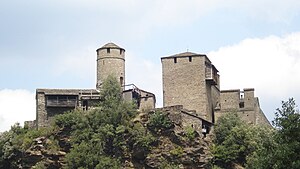Saint-Germain-de-Calberte
|
Saint-Germain-de-Calberte Sent German de Calbèrta |
||
|---|---|---|

|
|
|
| region | Occitania | |
| Department | Lozère | |
| Arrondissement | Florac | |
| Canton | Le Collet-de-Dèze | |
| Community association | Cevennes au Mont Lozère | |
| Coordinates | 44 ° 13 ′ N , 3 ° 49 ′ E | |
| height | 275-1,147 m | |
| surface | 38.60 km 2 | |
| Residents | 448 (January 1, 2017) | |
| Population density | 12 inhabitants / km 2 | |
| Post Code | 48370 | |
| INSEE code | 48155 | |
 Saint-Germain-de-Calberte - Château de Calberte |
||
Saint-Germain-de-Calberte ( Occitan : Sent German de Calbèrta ) is a place and a municipality in the south of France with 448 inhabitants (as of January 1, 2017) in the Lozère department in the Occitanie region . The municipality is located in the southeast of the Cevennes National Park .
location
The place Saint-Germain-de-Calberte is at about 500 m above sea level. d. M. on the upper reaches of the Gardon river in the Cevennes in the southern Massif Central . The next major city is Alès, about 45 km (driving distance) to the southeast .
Population development
| year | 1800 | 1851 | 1901 | 1954 | 1999 | 2013 |
| Residents | 1,669 | 1,826 | 1,211 | 584 | 485 | 445 |
Because of the remote location of the place and the increasing mechanization of agriculture , the population fell continuously in the first half of the 20th century.
economy
For centuries, the inhabitants of the community lived mostly as self-sufficient farmers from agriculture, which also included cattle breeding (sheep, goats, cattle, chickens). Pélardon cheese is still produced in the municipality today ; Chestnut and mulberry trees were also planted in sheltered locations or on terraced mountain slopes. Silk weaving flourished in the 18th and 19th centuries . As a regional economic center, the place was also attractive for small trade, crafts and smaller service companies. In the meantime, tourism plays an important role in the form of renting holiday apartments ( gîtes ).
history
From the Neolithic Age , some large stone monuments ( menhirs and dolmens ) have been preserved in the municipality . Later the Celtic Gabali tribe settled in the region. In the Middle Ages, the monks of Sauve Abbey used the area as summer pasture for their sheep and goats; later a priory was founded, which from then on formed the core for the further development of the place. After the end of the Albigensian Crusade (1209-1229) the area between the French crown and the sphere of influence of the bishops of Mende was disputed. In the 14th and 15th centuries, the Hundred Years War (1337-1453) and the plague decimated the population.
In the 16th and 17th centuries, the city came under Protestant influence, but this came to an end with the repeal of the Edict of Nantes issued by Henry IV in 1598 by Louis XIV (1685) and the subsequent Camisard Wars (1702-1705) . During this time inquisitorial punitive measures ( dragons ) were used in the mountain villages of the Cevennes.
Attractions
- The origin of the parish church of Saint-Germain dates back to the 14th and 15th centuries. Century back; The portal with some leaf capitals still dates from this time. However, it was later rebuilt several times - most recently in 1901 with the construction of the bell tower . Church construction has been recognized as a monument historique since 1984 . The equipment was up to the pulpit ( chaire ) in the revolutionary years destroyed.
- The sculpture of Homme Cevenol is located in the village and is intended to remind of the regional traditions of building with unprocessed natural stone. Many houses are now plastered, but covered with stone shingles ( lauzes ).
- The Château de Calberte ( 44 ° 13 ′ 35 ″ N , 3 ° 49 ′ 0 ″ E ), which dates back to the 11th century, rises on a hill surrounded by dense forest about one and a half kilometers northeast of the village. However, the facility was expanded several times by its respective owners in the following years, but was abandoned in the 15th century. It was only awakened from the ensuing slumber in 1963 when the new owner, a goldsmith, initiated restoration measures and opened the castle for exhibitions.
Web links
- Saint-Germain-de-Calberte, history - map + info (French)
- Saint-Germain-de-Calberte, history - photos + information
Individual evidence
- ↑ Église Saint-Germain, Saint-Germain-de-Calberte in the Base Mérimée of the French Ministry of Culture (French)

